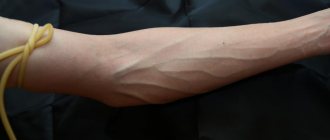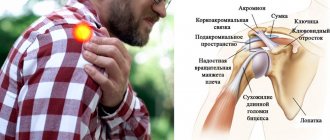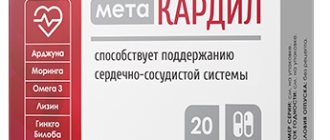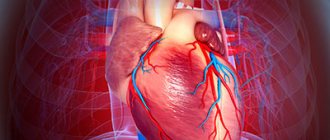- Normal blood pressure levels after training
- Causes of hypotension after exercise
- Signs of the condition
- How to control blood pressure during exercise?
- Acceptable workouts for hypotension
- Special set of exercises
- Recommendations for performing exercises
- Sports that you should not do if you have low blood pressure
Low blood pressure after exercise is a common occurrence that should never be ignored. This may be a signal of health problems. In fact, a decrease in this indicator after training is a sign that the body is overloaded and goes into power saving mode.
Causes of hypotension after exercise
Changes in blood pressure levels after active exercise can occur for reasons such as:
- Vegetovascular dystonia. This phenomenon does not pose a particular danger: in this case, there may be a drop in blood pressure after physical activity, which does not threaten the patient’s life. With VSD, after exercise, the lumen of the vessels returns to its previous state slowly, as a result of which a temporary decrease in indicators occurs.
- Mitral valve prolapse. Most often, this pathology affects tall young men with a thin physique. A decrease in pressure can occur even with careless movement, moving the body from a sitting to a horizontal position.
- Low level of physical fitness or fatigue. Each person’s body is able to tolerate a certain level of stress, so this reason most often explains the drop in blood pressure after exercise.
- Weakness of the sinus node, various types of heart block (bradyarrhythmias).
- Angina pectoris.
Read more about all possible causes of low blood pressure here.
Whatever the reason for the decrease in blood pressure after physical activity, you should immediately consult a doctor.
Causes of low blood pressure
Hypotension can appear in rare episodes when a person is simply not physically ready for such stress, but at the same time all his systems are working normally. This is why athletes choose training with a gradual increase in load. There are similar requirements for amateurs; if there is no special training, then there is no need to immediately strive for high results.
Factors not related to diseases can also affect blood pressure, for example:
- Fatigue, poor sleep.
- Hunger, dehydration.
- Hormonal changes (adolescent, drug-related, etc.).
- Lack of air in the room, high temperature.
Such causes are easily eliminated and subsequent loads pass as normal, but if attacks recur, then you need to look for the source of hypotension in your health.
In cases of frequent low blood pressure that occurs after exercise, additional diagnostic measures must be taken. The condition may worsen if the problem is ignored or if you choose medications on your own and take them to normalize the indicators.
If your blood pressure drops after training, there is a risk of developing the following diseases:
- Angina or cardiovascular dysfunction, including heart block.
- Vegetovascular dystonia. It occurs most often and is characterized as a temporary change in vascular tone. With increased tension, they partially narrow, which leads to a decrease in the blood circulation process. The reaction is not a serious pathological phenomenon and goes away on its own.
- Mitral valve prolapse. The disease occurs due to dysfunction of the valve located between the ventricle and the left atrium. If the pathology passes without complications, for example, without the development of arrhythmia or other disorders, then no special treatment is carried out.
- Chronic hypotension developing against the background of other serious diseases.
If your blood pressure drops after exercise, you don’t need to make diagnoses and take action on your own. This may be a temporary phenomenon associated with fatigue or slight malaise. Moreover, if you planned to play sports, then you don’t need to stop your endeavors, just check your health and choose the right training regimen. Even with diagnosed hypotension, there is a list of special sports that reduce the risk of attacks and have a positive effect on health and general well-being.
Signs of the condition
The main signs of hypotension that occurs during and after sports activities include:
- feeling of weakness, faintness (especially if the lower part of the body is involved during training: buttocks, legs, shins);
- increased drowsiness;
- dizziness when performing exercises in which the head is lower than the level of the body.
Most often, such signs are observed in people with an insufficient level of physical fitness. Over time, after the body adapts, the above symptoms disappear.
How to control blood pressure during exercise?
Doing sports has a beneficial effect on a person’s health and general condition. When performing certain exercises, it is necessary to observe the measure to prevent the opposite effect. To do this, you should monitor your blood pressure.
People who play sports professionally measure their blood pressure 20 minutes before exercise and 10 minutes after it.
It is also necessary to monitor your blood pressure during exercise. For these purposes, you can use a fitness bracelet. It will help not only track blood pressure levels, but also measure other indicators: heart rate, number of steps taken and calories burned.
Is there a need for exercise if you have hypertension?
Hypertension occurs due to the narrowing of blood vessels and the appearance of oxygen starvation in the cells. Negative emotions, excess weight, bad habits and a sedentary lifestyle contribute to vasoconstriction, after which blood moves through the arteries at increased speed. This raises blood pressure and increases the production of adrenaline, which negatively affects the functioning of the body’s cardiac system.
Physical activity, including sports, household chores, and walking, allows blood vessels to expand naturally. The blood restores its usual pattern of movement, which stabilizes blood pressure. The maximum positive effect is achieved during physical activity with emphasis on the legs.
Almost 25% of all capillaries in the human body are concentrated in the lower extremities. When walking or running, the capillaries open almost completely and fill with oxygen. The leg muscles serve as a kind of cardiac motor, helping the heart pump blood at a reflex level. The energy costs of the heart are reduced, thereby stabilizing the condition of the hypertensive patient.
Join the
Club of Former Hypertensive Patients
, download gymnastics that has already helped hundreds of thousands of people overcome pressure surges and hypertension. Get the most current and correct information about problems related to blood pressure, osteochondrosis, atherosclerosis, ask your questions to Dr. Shishonin and just communicate.
Acceptable workouts for hypotension
If a person suffers from low blood pressure after exercise, this does not mean that he should not lead an active lifestyle at all. With this problem, you can engage in sports such as:
- Swimming and water aerobics. A positive feature of these activities is the involvement of all muscle groups. During exercise, water puts pressure on the human body, thereby increasing the elasticity and filling of blood vessels.
- Jogging. It is better to start this exercise with a calm walk, gradually increasing the pace, while the running speed should not exceed 7-8 km/h. You should also gradually increase your jogging time. It is very useful to combine jogging with brisk walking.
- Dancing. There are many types of dance, but not all are suitable for people with low blood pressure. It is necessary to give preference to dances that are characterized by a calm pace, without sudden movements. Oriental or ballroom dancing is perfect.
- Yoga. If you choose this type of physical activity, you should consult with a specialist so that he can develop an individual set of exercises, taking into account the characteristics of the body.
- Cycling. During the ride, the leg muscles are actively involved, causing the blood to rise upward. This ensures its free circulation and, accordingly, relieves stagnation.
People with hypotension engaged in spores are advised to carry a bottle of sweet water with them. You need to drink it little by little, in between. It is best to exercise in the morning or evening.
Special set of exercises
It is also useful for people with low blood pressure to perform the following exercises:
- Ordinary walking. At first you need to limit yourself to 5-10 minutes, then gradually increase the time (but no more than half an hour).
- Pushups. During the exercise, you need to keep your back straight and place your arms slightly wider than your shoulders.
- Abs training. Take the starting position (lying on your back, feet on the floor, hands behind your head). First, raise your head, neck and shoulders, and then your upper body. The exercise must be performed slowly, at an average pace.
- Squats. It is important not to bend your back while doing squats.
- Lunges forward. The technique is as follows: take a step forward, with your back straight, after which the knee of the front leg bends approximately 90 degrees. Then you need to return to the starting position. The same exercise is performed on the other leg.
- Bike. You need to lie on your back, raise your legs and spin imaginary pedals.
- Scissors. For arms, this exercise should be performed in a standing position, for legs - lying on your back.
- Holding your legs. You need to lie on your back, arms and legs should be in line. The head comes off the floor, and the feet rise above its level by 45 degrees. Hold this position for no more than 5 seconds, then return to the starting position. It is recommended to do 5-7 repetitions.
Regular repetition of the above exercises will help reduce the symptoms of low blood pressure. After two weeks of exercise therapy, blood pressure levels will return to normal, and the activity of the heart muscle and lungs will improve.
It is important to breathe correctly during exercise. Experts recommend breathing through your nose. It is necessary to compare motor acts with the rhythm of breathing.
Breathing exercises are an integral part of any training process. Experts recommend doing them 3 times a day. They need to be done before and after the main workout. When performing breathing exercises, it is important to control not only the intensity of inhalation and exhalation, but also the frequency of the rhythm. Regular breathing exercises will activate the respiratory tract system and fill the body's cells with oxygen.
Exercise and hypertension
An increasing number of people are experiencing high blood pressure—about one in three adults. How can (and can) training help with this?
Data from the current and ongoing NHANE study: 85.7 million US residents aged 20 years and older have hypertension - that's 34% of the adult population. Available statistical data for Russia indicate that at least 40% of our population suffers from hypertension.
Moreover, hypertension now occurs even in children. According to guidelines released by the American Academy of Pediatrics in September 2021, 3.5% of current U.S. children and adolescents have hypertension. In the absence of rare diseases such as pheochromocytoma or renal failure, children should not have hypertension.
Things only get worse from there. The Framingham Heart Study identified the risk of developing hypertension in approximately 1,300 subjects aged 55 to 65 years who did not have high blood pressure at the time of follow-up: more than half of participants aged 55 years and about two-thirds of participants aged 65 years developed hypertension in over the next 10 years. The authors concluded that “ the lifetime risk of developing hypertension in middle-aged and elderly people is 90%!”
».
There needs to be better medical advice on the role of exercise - we're talking practical advice about exercise. Doctors are clearly not doing everything they can. What is meant here is the recommendation: “You need to exercise more. I instruct you to walk 30-45 minutes a day, 5 days a week, and please start today.” It’s sad to realize that such a conversation is a rare occurrence in medical practice. Doctors simply don't have the knowledge to give advice about exercise. It’s much easier to write out the required prescription and give a piece of paper with recommendations for yourself to review.
Can regular exercise prevent the development of hypertension?
- A study of Harvard University alumni over the years by Dr. Ralph Paffenbarger led to the following conclusions: Those who did not participate in active sports were 35% more likely to develop hypertension compared to those who exercised regularly.
No less significant is another conclusion:
it was intense training, and not training at an easy pace, that reduced the risk of developing hypertension throughout life
. In this case, “intensive” training included running, swimming, handball, skiing competitions, etc. - A study of Japanese men found that Walking for 20 minutes every day reduces the risk of future hypertension
.
- More recent data suggests that active rest totaling at least 4 hours per week reduces the risk of hypertension by 19%
.
Although the above may not apply to everyone, chances are good that regular exercise can actually prevent the development of hypertension.
"Normal" blood pressure
For many years, optimal blood pressure was considered to be 120/80 (systolic/diastolic). Medicines were prescribed for blood pressure of 140/90 and higher. When conducting the study, scientists calculated that with an increase in pressure from 115/75 to 185/115 mm Hg. Art. Each unit increase equal to 20/10 doubles the risk of cardiovascular events
, such as heart attack (myocardial infarction), heart failure, stroke and kidney disease.
People who engage in aerobic exercise tend to have lower resting blood pressure than those who are less physically fit
. This is not harmful and is not unusual. Improving adaptability to aerobic exercise leads to improved functioning of the circulatory system: the heart becomes stronger, it pumps more blood with each beat, and the body receives more oxygen from the blood.
A trained athlete consumes more oxygen than a sedentary person. The increased output of blood with each heartbeat, combined with higher oxygen consumption, results in lower resting blood pressure values and a slower heart rate.
The immediate effect of aerobic exercise on blood pressure
Research examining the effects of exercise on hypertension has been conducted since 1970, and many reviews (meta-analyses) of such studies have subsequently been published. But let's first define the difference between the immediate effect of a single workout on blood pressure and the long-term effect of regular exercise on hypertension.
When it comes to immediate effects, blood pressure can vary over a fairly wide range depending on the type of physical activity.
During aerobic exercise (intense endurance exercise - running, triathlon, swimming, skiing), the heart rate can rise to very high values, while the pressure usually remains fairly stable. However, abruptly stopping exercise, say after a long run, can lead to an equally dramatic drop in blood pressure.
The suspected cause of this phenomenon is blood flow to the legs (hence, less of it returning to the heart). This explains why some athletes feel dizzy after running long distances.
If you are familiar with this condition, here are some tips:
- Don't stop or sit down suddenly after finishing a long run, cyclocross, or tennis match, especially if you're noticeably sweaty.
- Continue walking at a leisurely pace for a few minutes.
- Massaging the leg muscles will also be helpful to normalize blood flow to the heart.
- If dizziness persists, lie on your back and elevate your legs.
- Drink more fluids and eat something salty - this will regulate the fluid balance in your circulatory system and have a positive effect on blood pressure.
The immediate effect of strength training on blood pressure
During truly intense anaerobic (strength) exercise, blood pressure can reach truly astronomical levels. For example, scientists measured that a bodybuilder performing a leg press had a brachial artery pressure of as much as 480/350.
Even a short-term increase in pressure to such values gives cause for concern. What happens to your heart and blood vessels in such cases?
Instant Effects of Various Types of Cardiac Exercises
Obviously, a high heart rate puts significant strain on the heart. The same applies to high blood pressure.
Both aerobic and anaerobic exercise put stress on the heart, but this happens for different reasons: during aerobic exercise, the heart rate increases to very high values, while the blood pressure increases slightly
.
Resistance exercise tends to have the opposite effect: a spike in blood pressure at a moderate heart rate
.
To compare the two mentioned types of physical activity, the so-called frequency-pressure coefficient (i.e., heart rate X blood pressure) is sometimes used. Note that in some cases the load on the heart when performing aerobic exercises may be higher than during strength training.
Aerobic training improves vascular elasticity
If you are in good physical shape, the positive effects are also noticeable on the blood vessels: the diameter of the heart arteries increases, it becomes possible to counteract the negative effects of atherosclerosis, and the ability of the arteries to dilate also improves. All this is called the term “increased vascular elasticity”, which is achieved by increasing the efficiency of the circulatory system as a result of regular aerobic exercise.
For example, runners and swimmers have better elasticity of the cervical arteries compared to people accustomed to a sedentary lifestyle. According to the study, older men with diagnosed hypertension experienced an average reduction in systolic blood pressure of 9 units and an improvement in arterial elasticity of 21% following a 12-week swimming program.
These are the results you should strive for!
In another study, in which participants walked/ran 5 times a week for 3 months, the pressure remained at the same level, but the scientists noted a restoration of the ability of the arteries to expand in the participants
.
Obviously, aerobic exercise has a positive effect on your blood vessels, even if standard blood pressure measurements show no improvement.
However, prolonged exposure to increased pressure on blood vessels during resistance training can lead to deterioration of vascular elasticity.
Forceful - impairs the elasticity of blood vessels
Young people who have been involved in strength training for at least 12 months
who did not perform any aerobic exercise
demonstrated vascular elasticity 26% lower than that found in people with a sedentary lifestyle
.
Another similar study of men who performed anaerobic exercise for more than 2 years had 30% lower vascular elasticity
.
Let's add data from a third study - in it, the subjects took part in a 4-month strength training program, before and after which their vascular elasticity was measured. The result is a 20% deterioration in the indicator after 2 months of classes.
.
What leads to such consequences? It is clear that artery walls respond in a specific way to extremely high blood pressure during strength training. They become stronger, yes, but also tougher. Despite the protective nature of this response mechanism, this situation cannot be called positive. The vessels must be as elastic as possible in order to narrow and expand if necessary.
These studies suggest that arterial elasticity increases with aerobic exercise and may decrease with anaerobic exercise. Adding to the concern is the fact that changes in a negative direction are not always noticeable by standard pressure measurements.
At the same time , new research data are emerging indicating a possible higher benefit of anaerobic training for hypertension
compared to established beliefs.
Now, many experts in the field of medicine are of the opinion that strength training is highly effective on its own
, while in the past such exercises always occupied second place in importance after aerobic exercises.
Vascular training program
So, how can you create a training program that does not harm the elasticity of blood vessels?
Of course, no one advises completely abandoning anaerobic training. All people, especially older people, should do weight-bearing exercises.
Here are 3 recommendations that it would be wise to follow, regardless of whether you have hypertension or not.
1. If you only perform weight training exercises, then stick to an intensity equal to 70% of your one-repetition maximum (1RM).
Research findings suggest that when performing anaerobic exercise with heavy weights, vascular elasticity suffers. An analysis of 8 studies found that arterial elasticity actually worsened when participants performed repetitions of 70% or more of their 1RM.
.
At the same time, more modest values of weights within 40-70% of the maximum did not cause negative changes.
The study, which included 35 elderly Korean men, found that vascular elasticity improved (albeit slightly) after resistance training. Yes, the subjects trained 5 times a week for a year, but the intensity of the training could hardly be called high: the weights were kept within 60% of the one-repetition maximum
. And in general, we are talking about older people!
The American Heart Association is even more conservative: people with hypertension should train at 30-60% of their maximum resistance.
. For example, if your maximum in the bench press is 50 kg per rep, then the working weight during training should be in the range of 15-30 kg.
2. Do not perform more than 1-2 approaches
The studies mentioned showed that resistance training at 50% of maximum still reduced vascular elasticity by 20% when performing 3 sets of each exercise
. Therefore, limit yourself to 1-2 approaches, regardless of the training weight, or do not forget to perform aerobic exercises.
3. If you are training with a weight greater than 70% of your maximum, include aerobic exercise in your weekly training program
The study findings suggest that training at 80% of 1RM did not impair vascular elasticity when subjected to regular aerobic exercise. In one study, participants performed 3 sets with a weight of 80% of the maximum, i.e. we can say that the training program was quite intense. However, when included in the program of aerobic exercise with a frequency of 3 times a week, no negative effects were noted on the elasticity of the arteries
.
- People with hypertension should not avoid weight-bearing exercise. However, if you are a fan of this type of training, limit your weights to low to moderate levels. And add aerobic exercise to your training program.
In the same case, if you have hypertension and you decide to do only one type of exercise, give preference to aerobic training.
Long-term effects of exercise on hypertension
Until very recently , there was consensus that aerobic exercise was better for people with hypertension than anaerobic exercise.
A 2013 review of 93 studies found that aerobic training was superior to resistance training for lowering blood pressure in hypertensive patients. The average reduction in blood pressure in patients with hypertension during aerobic exercise is an average of 8/5 (systolic/diastolic) points, and during anaerobic exercise there is a slight decrease, close to zero.
A large review published in 2002 showed the effectiveness of aerobic exercise in lowering blood pressure not only in patients with hypertension, but also in people with normal blood pressure, obese people and people of normal weight. The average reduction in blood pressure was 3.9/2.6 (systolic/diastolic). When analyzing exclusively hypertensive patients, the average pressure reduction was 4.9/3.7.
Data from a Japanese study are even more impressive: performing aerobic exercise achieved a reduction in blood pressure of as much as 20/10 (systolic/diastolic) after 20 weeks.
Let's take a closer look at the types of aerobic exercises and their effect on blood pressure.
Running and hypertension
In a University of Florida study, 101 of 105 participants with hypertension were able to lower their blood pressure by running 2 miles (about 3.2 km) daily for 3 months.
.
A study in Germany included 10 middle-aged men who took part in a running program lasting 3 years. They ran 60 minutes a day, 2 times a week, with a target heart rate of 60-70% of the established maximum, depending on age. As a result, after 3 years, systolic pressure decreased by 16 units, diastolic - by 15
. By the way, not all medications to lower blood pressure have the same pronounced effect.
The conclusion of one of the doctors (Paul Williams, PhD) states that the runners he examined reduced the amount of medications they took for hypertension with a gradual increase in weekly running distance and corresponding positive changes in the activity of the cardiovascular system. A study from the University of Florida showed more impressive results: 24 out of 105 patients with hypertension completely stopped taking pills while sticking to a daily running program.
Cycling and hypertension
In one study, participants rode an exercise bike 3 days a week for 20 weeks. The training intensity was initially set to “moderate” (55% of VO2MAX) for 30 minutes and was subsequently increased to “vigorous” (75% of VO2MAX) for 50 minutes per day. However, at the end of the study, the decrease in participants' blood pressure was not significant (less than 1 point for both systolic and diastolic). This result, however, does not mean that cycling is useless to lower blood pressure. In this study, participants' baseline blood pressure readings were not significantly elevated, providing a likely explanation for the small effect.
Another study in Japan found that moderate-intensity cycling (50% of VO2MAX) 60 minutes a day, 3 days a week for 20 weeks reduced blood pressure by more than 20/10 units.
(systolic/diastolic).
Swimming and hypertension
Swimming is an ideal activity for people with knee or hip pain, as well as for those who for some reason cannot walk or run quickly. At the moment, there are not many studies that would evaluate the effect of swimming to lower blood pressure, but the available data indicate quite high effectiveness.
One study from the University of Texas at Austin involved adults 50 years of age and younger who had hypertension but were not taking any blood pressure pills. After completing a 12-week swimming program, there was a 9-point reduction in systolic blood pressure and a 21% improvement in cervical artery compliance.
.
How intense should aerobic training be?
When it comes to preventing the development of hypertension as you age, the previously mentioned study involving Harvard graduates showed the benefit of high-intensity training compared to a moderate pace. But what if you already have hypertension? Should aerobic exercise be equally intense in this case?
In one study, sedentary people completed an aerobic training program lasting 45 minutes a day at an intensity of 70-85% of their individual maximum effort. The exercises themselves, performed 3-4 times a week for 6 weeks, included cycling, running or brisk walking. At the end of the program, the subjects showed a decrease in systolic and diastolic pressure by 6 units.
Without a doubt, this is a good result, but not everyone can do training with such a load. Will there be an effect from less intense exercise?
It turns out that even regular walking helps lower blood pressure.
.
In one study, researchers concluded that after regular walking for 25 weeks, blood pressure decreased by 3/2 units (systolic/diastolic)
. Other studies showed more impressive results:
- In a study of postmenopausal women that included walking 3 kilometers every day for a total of 24 weeks, the resulting decrease in systolic pressure was 6 units.
In general, we can say that absolutely all types of aerobic exercise have a positive effect on reducing blood pressure.
The effectiveness of anaerobic exercise
As mentioned earlier, most studies have concluded that aerobic exercise lowers blood pressure more than anaerobic exercise.
However, in 2012, Brazilian researchers recorded a decrease in systolic and diastolic blood pressure of 16 and 12 units, respectively, after participants completed a 12-week training program with a load of 60% of 1RM. This result was much more noticeable than earlier findings. The only disadvantage of the study is the small number of subjects - only 15 people.
An extensive review of published studies released in 2016 only confirmed the findings of Brazilian experts. Its authors concluded that resistance exercise was as effective in lowering blood pressure as anaerobic exercise, and perhaps even more effective.
One 2021 study found that isolated anaerobic exercise (i.e., without accompanying aerobic exercise) reduced systolic and diastolic blood pressure by 8 and 4 units, respectively.
New research data is forcing experts to reconsider the role of strength training in the treatment of hypertension.
Official recommendations regarding exercise for people with hypertension
Although the first evidence of the effectiveness of exercise to combat hypertension appeared back in 1973, only recently has the medical community paid attention to the very idea of recommending exercise as a means of treating certain diseases.
Until 2002-2004, there was no consensus on which means of combating hypertension were most effective. Back then the emphasis was on aerobic exercise.
In 2002, the National High Blood Pressure Education Program recommended the following: "regular aerobic physical activity, such as brisk walking, for at least 30 minutes per day on most days of the week."
In 2004, the American College of Sports Medicine (ACSM) released a recommended exercise plan for those suffering from hypertension. It included 4 elements, represented by the acronym “FITT”: frequency, intensity, time, type.
Frequency:
You should exercise on most days of the week, ideally every day.
Intensity:
Moderate exercise intensity (40-60% of VO2MAX) is recommended.
Time:
The duration of classes should be at least 30 minutes per day. This can include either a single long workout or a sum of shorter periods of activity throughout the day.
Type:
Preference should be given to aerobic exercise, but you should not completely abandon anaerobic exercise.
- If we try to convey the entire meaning of the above recommendations in one sentence, we get something like this: Walk at a brisk pace for 30-45 minutes a day, 5-7 days a week.
.
However, we are talking about recommendations published in 2004. As discussed above, newer research shows that resistance training is no less effective than aerobic training for people with hypertension.
This led to experts being forced to change their recommendations. Linda Pescatello was the lead author of the 2004 ACSM guidelines. And in 2015, she and her colleagues released a paper called “Exercise for People with Hypertension: Updating Recommendations to Based on Recent Research.” This document still advises aerobic exercise, but states that patients should also include anaerobic exercise 2-3 times per week.
.
Who is not recommended for training?
Although exercise can be effective in treating hypertension, you should not start a new exercise program without first talking to your doctor, especially if you have any cardiovascular disease.
If you are currently taking medications to lower blood pressure, then, as a rule, intense exercise is contraindicated until your blood pressure drops to more acceptable values. It is especially important to follow this recommendation for older people and those whose blood pressure is assessed as very high.
Stop exercising if:
- Your resting blood pressure is greater than 200/110,
- During exercise, your blood pressure rises to 220/115 or higher.
If you experience chest pain during exercise, stop exercising immediately.
High Pressure Training: Conclusions
- To lower your blood pressure, the best option is a combination of exercise, healthy eating and, if you are overweight, losing weight.
- If you have high blood pressure or any cardiovascular disease, do not start high-intensity exercise without first consulting your doctor.
- Focus on aerobic exercise
.
When you reduce your blood pressure to lower values, incorporate anaerobic training into your program
. - Although intense aerobic exercise can be effective, moderate-paced exercise is also beneficial. Walking and cycling can successfully lower blood pressure. For older patients, especially those with knee or hip pain, swimming is recommended.
- If you are overweight or obese, lose weight.
- Switch to a plant-based diet. Not all people are able to reduce blood pressure solely through aerobic exercise. Combining this type of training with a healthy diet may be more effective.
Hypertension is a condition that usually persists throughout life. However, there is considerable evidence that regular exercise, combined with losing weight (if you are overweight) and limiting your salt intake, can reduce high blood pressure. Moreover, physical exercise successfully helps with other diseases of the cardiovascular system.
More importantly, these lifestyle changes can completely prevent the development of hypertension in the future.
.
Recommendations for performing exercises
During training, you must adhere to the following rules:
- Regularity of classes. You need to do the exercises every day, remembering to alternate them and add new ones. It is also recommended to change the nature of the exercises and the number of repetitions.
- Duration of training (at least 3 months). A set of exercises for people with low blood pressure was designed in such a way that the effect was visible within a week after the start of exercise. But this does not mean that after a week you should stop training. Regular training over a long period will help not only significantly improve your condition, but also consolidate the results.
- Gradual increase in loads. If a person with hypotension decides to engage in physical exercise, then in the initial stages he should under no circumstances put too much strain on himself. This is due to the fact that the patient’s body must adapt to new conditions. In the case of a “sharp start,” certain problems with well-being may arise during the training process: headache, poor health, severe weakness. If they occur, it is necessary to stop physical activity, as this can provoke loss of consciousness.
- When training, it is very important to monitor your blood pressure; if they decrease, it is necessary to reduce the load level.
Why exercise is more effective than drugs for hypertension
For patients with hypertension over the age of 40, doctors most often prescribe medications to lower blood pressure and bed rest. This method does not help treatment, but dulls the manifestations of the disease. By taking medications, hypertensive patients temporarily heal the symptoms, but the disease continues to progress. The tablets artificially dilate blood vessels, but do not reduce the production of adrenaline.
Lying down makes the situation even worse. The lack of physical activity weakens the muscles of the musculoskeletal system, which transfers all energy costs to the heart. It cannot cope with pumping blood through the vessels, and the body is forced to connect other vital systems. This leads to pressure surges. Gradually, the dose of medications increases, the body gets used to it and requires more. As a result, taking medications becomes useless, and the patient’s condition becomes weakened.
Benefits of exercising to lower blood pressure:
- saturation of all muscles, joints and blood vessels with oxygen;
- natural strengthening of the body's cardiovascular system;
- restoration of muscle tone, a surge of strength and vigor;
- burning excess fat and salt, which contribute to the development of hypertension.
Thus, the persistent demands of doctors to “rest” during a hypertensive crisis are nothing more than an unfounded myth. An active lifestyle, proper nutrition, breathing exercises and moderate exercise are the best means to combat high blood pressure.
Sports that you should not do if you have low blood pressure
Professional sports, as a rule, involve increased stress on the body, which should not be allowed for people with low blood pressure. Therefore, if you have hypotension, it is strictly forbidden to engage in sports such as:
- Weightlifting;
- body-building;
- motorsports;
- powerlifting;
- figure skating;
- hockey;
- acrobatics;
- marathon, sprint running;
- struggle;
- martial arts;
- some types of dances, for example breakdancing.
Before you start exercising, you should consult a doctor who will help you determine which specific sport is indicated in a particular case. The specialist will also give recommendations regarding the intensity of physical activity.
Hypotension after physical activity is not a reason to stop playing sports. With this problem, it is important to choose the right type of sports activity and the degree of intensity of the load. During the training process, it is necessary to monitor blood pressure and other indicators. It is best to exercise under the supervision of an experienced specialist.
Signs of low blood pressure
When training or performing heavy physical work, a tonometer is not always at hand, but even without a special device, problems with arterial indicators can be assumed. The following signs are characteristic of hypotension:
- Darkening or blurriness of the eyes. It is difficult to focus your vision.
- Dizziness, tinnitus, sensation of pulsation in the temples, especially when tilting the head.
- Weakness in the limbs.
If after physical activity the pressure drops, it is difficult not to notice this, since the person feels pre-fainting. In such cases, it is imperative to rest and not to overload the body to clarify the circumstances.










